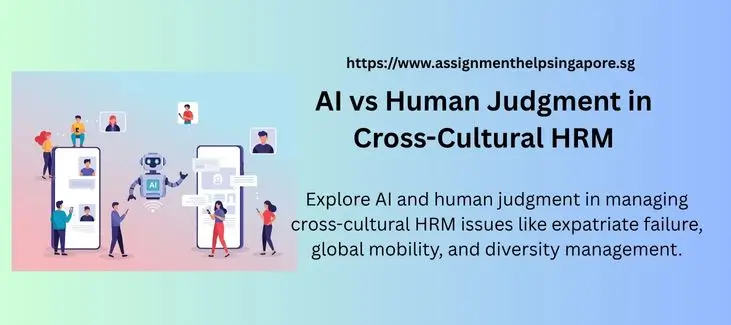
Contents
AI vs Human Judgment in Cross-Cultural HRM
Description of the assignment, task, content and structure:
Global businesses face people-management challenges across different cultural and institutional environments. Common problems include failed expatriate postings, complex global talent moves, and leading diverse international teams. These situations create tension between “one global HR way” and what actually works locally.
In this assignment you will:
• Use a country lens: Identify 1–2 HRM issues in your own country that make cross-border people management harder for international organisations.
Examples: hiring in a highly regulated labour market, performance management that clashes with local norms, reward practices shaped by law or custom, expatriation/repatriation hurdles, or diversity and inclusion challenges.
• Pick one cross-cultural HRM scenario: choose one of the following and link it to your country issues:
1. Expatriate assignment failure
2. Global talent mobility
3. Managing diverse international teams (including remote/hybrid)
• Use AI tools (such as ChatGPT, Claude, or an HR simulator) to generate solutions such as training modules, onboarding materials, relocation policies, conflict-resolution approaches, or support systems.
• Benchmark the AI against peer-reviewed research in cross-cultural HRM/international management and professional guidance (For instance, CIPD, SHRM, credible case studies).
• Reflect on limits: Show where AI oversimplifies or misses cultural nuance, legal specifics, and ethical issues.
• Propose a decision framework: Explain when AI-generated insights are helpful and when human expertise is essential.
Why this matters
What works in one country often fails in another. This task helps you connect theory with real
contexts, test AI critically, and make practical judgments like an HR professional.
Suggested Scaffolded Structure
1. Introduction (400 words)
Introduce your chosen HRM scenario (for instance expatriate failure, global mobility, or managing diverse teams) remember you can include any HRM Scenario of your choice, but it is important you provide adequate evidence.
• State your country focus and why it matters in cross-cultural HRM.
• Outline the purpose: testing AI solutions against theory and human judgment.
• why is this issue worth studying? Provide adequate Justification
2. Country HRM Issues (400 words)
Identify 1–2 HRM challenges in your country that affect global organisations. • Support with evidence (laws, statistics, reports, or real company examples).
• Show how these issues connect to your chosen scenario.
• Reflective on; How do these issues play out in your context? What has worked or failed in practice?
3. AI-Generated Solutions (400 words)
• Summarise AI’s suggested solutions
• Comment on your first impressions: did AI provide practical, culturally aware ideas, or was it too generic?
• Reflective thinking: How did you feel about using AI? Did it surprise you, or did it confirm expectations?
4. Evaluation: AI vs Theory and Practice (800 words)
• Compare AI’s outputs with academic theories (for instance, Hofstede, Trompenaars, GLOBE, Institutional Theory, SHRM).
• Contrast with professional guidance (CIPD, SHRM, case studies).
• Identify alignments and gaps.
• Evaluative thinking: Which approach is stronger, and why? Do AI’s outputs hold up against research and professional standards?
5. Reflection on AI’s Limits (400 words)
• Show where AI fell short: cultural nuance, legal details, ethics, or bias.
• Use examples from outputs to demonstrate oversimplification or error.
• Reflective thinking: What did you learn about AI’s limitations through this task? How would this affect your own practice as an HR professional?
6. Framework for Practice (300 words)
• Provide a clear, practical decision framework (table, diagram, or bullet list):
• When AI can help?
• When humans are essential?
• Why does your framework make sense? What are its strengths and possible weaknesses?
7. Conclusion (300 words)
• Summarise the main findings.
• Re-state AI as a support tool, not a replacement.
• Emphasise what this means for the future of HRM practice.
• What is the “big lesson” for you and for organisations?
Refences (Peer reviewed Journals, CIPD, Government, Business annual reports) 8. Appendix
• Full AI prompts and outputs.
• Short note on your process: what you learned about working with AI.
HRM Assignment Answers: Expert Answers on Above AI Vs Human Case
Introduction
The main focus of analysis is on exploring how AI and human judgement interact with each other in managing class cultural HRM challenges in Singapore. The scenario selected for the purpose of analysis is global talent mobility. This is mainly because Singapore is known for hosting many expatriates and international professionals. The findings of the study will reveal how AI generated HR solutions links with cultural realities and leadership theories.
Country specific HRM issues
The two challenges as identified in Singapore in relation to human resource management are expatriate integration and Diversity management. Expatriate integration is a challenge because professionals from foreign countries often struggle with adapting to local culture and social norms in Singapore. Secondly, diversity management is another HRM issue as Singapore is known for having a multicultural workforce including Chinese, Indian, Malay and many other expatriates which requires culturally sensitive leadership and communication styles.
AI generated solutions
The use of AI tools such as chat GPT proposed the following:
The onboarding programs should be culturally focused and integrate digital mentorship. AI analytics to provide training on data driven and expatriates to be provided with relocation support resources.
Evaluation: AI vs theory and practice
The output generated by AI closely aligns with the HR models but it fails to integrate the contextual nuances. The AI solutions are highly generic when they are compared to Hofstede’s cultural dimensions such as high power distance, collectivism etc. Strategic human resource management emphasizes cultural empathy and adaptability which is clearly lacking in case of AI.
Reflection on AI limits
The use of AI leads to simplification of cultural and legal aspects, and issues like work passes, employment laws and religious sensitivities are ignored. The AI also lacks emotional intelligence and ethical reasoning which are crucial in managing people in Singapore’s multi-cultural context.
| Disclaimer: This answer is a model for study and reference purposes only. Please do not submit it as your own work. |
Want a Full Worked Out Answer with References?
Tasks based on cross cultural human resource management are complex and sometimes require additional support. With our professional HRM experts, you get complete guidance and support with step by step explanation that allows you in completing your assignment on time. Connect with our assignment help experts in Singapore for a positive learning experience.
Check Samples on HRM Assignment Written by Experts
Related answers
Workplace Diversity & Allyship in Singapore – HRM358
AI in Talent Acquisition: Applications, Risks & Strategy
Singapore Work Permit Revamp: Longer Tenure, New Sources
Talent Management Dilemmas: HR Decision-Making with AI
Employee Engagement Priorities at Innova Code: Key Focus Areas
Strategic IHRM Case Study Report: Global HR Challenges
Reflective Skills Analysis and Future Success Action Plan for MBA
Human Resource Management Strategy Assignment Answers



